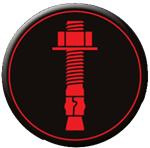 Mechanical & Adhesive Anchors
Mechanical & Adhesive Anchors
Aerosmith® now carries a full line of anchors that meet the criteria for use in cracked and uncracked concrete, Category 1!
Pin fastening has been commonplace in commercial construction for over 50 years with a solid history for fastening to both concrete and structural steel. However, many people are still unaware of how a pin can fasten to the hardest concrete or multiple gauges of steel. Many times, even more secure than a conventional fastener. Pin design and select driving systems are the keys to the pin’s performance technology. Ballistic pins are made from special grades of steel that are hardened through unique heat-treating processes, making them ductile and extremely strong. The result: higher tensile and shear values.
In steel, pin ballistic-shaped points uniformly pierce the steel instead of drilling it out or tearing it like a common nail or screw. This ‘forced entry’ displaces steel which then rebounds around the pin to create a strong compressive force against the shank of the fastener. This force works in conjunction with a specific pin knurling pattern designed for the steel being joined. Pins are available in a variety of knurls the most common being a helical knurling pattern, and generally used for attaching a variety of materials to 97-54 mil steel. Some contractors will use a fastener with a GripshankTM knurling pattern for attaching materials to steel ranging from 54-27 mil.
In concrete, pins enable a fast, secure connection to both aged or today’s ‘ad-mix’ material. Here the delivery systems (tools) enable fast installations in hard to reach areas like those overhead. Variety of pin length, shank design and head size are available for a specific range of applications, matching unique characteristics and performance capabilities to the concrete being fastened. Proper pin design and knurling pattern selection improve holding strength and connection durability that can surpass that of conventional fasteners. Practical demonstration of this kind of holding power has been documented when ‘slab built’, steel frame buildings fastened with pins survived 120 MPH hurricane force winds!
In addition to the strength and durability of a pin its speed of installation surpasses convention. A majority of pins are installed with air or gas powered tools which have been used in construction for decades. Advantages here are accuracy, consistency, depth of drive controls, and large magazines. However, the biggest advantage is that pin installation is often three to seven times faster than that of a mechanically installed screw or a powder actuated tool. This allows installers, contractors, architects and engineers to achieve numerous cost benefits. Pneumatic speed advantages are compounded and improved where a single air tool can perform a wide variety of a project’s applications. This not only cuts time on the job, but also contractor tool investment.Project times can be shortened and can greatly reduce overall costs. Savvy contractors are then building these savings into their bids to win more contracts!
Related Topics: Pin Nailers and Nail Guns, Industrial Fasteners, Construction Fasteners and Fastening Tools